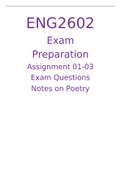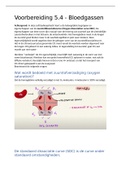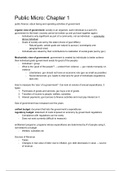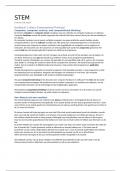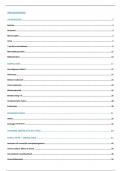ENG2602
Exam
Preparation
Assignment 01-03
Exam Questions
Notes on Poetry
,Table of Contents
Assignment 01: (76%)............................................................................................................................3
Section A:...............................................................................................................................................3
Section B:...............................................................................................................................................3
Section C:...............................................................................................................................................3
Section D:...............................................................................................................................................3
Assignment 02: (78%)............................................................................................................................6
Assignment 03:......................................................................................................................................8
Exam Questions:..................................................................................................................................10
Question 1:......................................................................................................................................10
Answer:............................................................................................................................................10
Question 2:......................................................................................................................................11
Answer:............................................................................................................................................11
Question 3:......................................................................................................................................14
Question 4:......................................................................................................................................21
QUESTION 5:....................................................................................................................................25
QUESTION 6:....................................................................................................................................27
QUESTION 7:....................................................................................................................................29
QUESTION 8:....................................................................................................................................32
QUESTION 9:....................................................................................................................................35
Act One............................................................................................................................................35
Qyestion 10:.....................................................................................................................................37
Notes:..................................................................................................................................................39
,Assignment 01: (76%)
Section A:
Section B:
• Identify:
In this context identify means to recognise and name the structure of the text. Its
function is to name the specific structure.
• Specify
In this context specify means to stipulate the three elements purpose in the text. This means you
should explain the purpose specifically of the three elements Briefly explain how each of them
achieves its purpose.
In this context it means you should just explain how the elements asked for accomplishes its
purposes.
Section C:
● Identify:
In this context identify means to name and recognise the thesis of the text.
● Justify:
In this context justify means to explain and validate your choice of thesis of the text.
This means you should explain the thesis of the text and why you chose it.
● Provide a motivation for your thesis statement:
In this context provide a motivation means you should give a motivated and well explain answer to
why you chose your thesis statement.
Section D:
● Identify:
In this context identify means to name the three features they ask in the question.
● Critically analyse:
In this context critically analyse means to critically evaluate and explain the function of the three
features. This means you should explain the features, their function, what they serve in the text and
why they are used.
● Offer relevant textual evidence:
In this context to offer relevant textual evidence means to give proof from the text given that is
related to the context and question asked about the three features.
Section B:
The structure of this text is a problem-solution structure.
Introduction:
The purpose of the introduction is to introduce the topic and indicate the problem that is going to be discussed
in the text that is to come.
The text opens with a clear statement that immediately involves the topic problem. This element of
introduction achieves its purpose by beginning with the problem topic identified “Since the outbreak of the
COVID-19 virus and declaration of the pandemic, the UN Secretary General and other senior leaders of the UN
and its institutions have increasingly drawn attention to the challenge of the “infodemic” or misinformation and
disinformation pandemic.” that identify the topic of the text immediately and the content of the rest of the
text.
, Body:
The purpose of the body is to develop the solutions, expand the topic about the problem further and persuade
the reader that the solution is the best in the text by using emotive language, tone of text and figurative
language.
The body achieves its purpose by the tone of this text which is serious to persuade the reader about how
problematic misinformation can be, the body has emotive language such as “negative”, ”dangerous”, “crucial”
and “violence” to persuade the reader further about “fake news” and “infodemic” and that it is dangerous. The
body also contains figurative language such as a simile “…as a toxic driver…” to compare the fact of
misinformation.
Conclusion:
A possible solution to the problem stated in the text is offered.
The conclusion achieves this purpose by offering the solution for the “infodemic” and explaining that all
countries have to take steps to stop the spreading of misinformation.
Section C:
Thesis statement:
“In times of the COVID-19 health crisis, the spread of the “infodemic” can be as dangerous to human health and security as
the pandemic itself.”
This sentence is the thesis statement because it is summarising the main point of the text about spreading
misinformation can be a danger to the society, people’s health and security. It is explicit and is stating that the
rest of the text is about how fabrication about COVID19 can be harmful and dangerous. Paragraph 1:
Topic sentence:
“Since the outbreak of the COVID-19 virus and declaration of the pandemic, the UN Secretary General and other senior leaders of the UN
and its institutions have increasingly drawn attention to the challenge of the “infodemic” or misinformation and disinformation pandemic.”
The first sentence in the paragraph, stating the main point of the paragraph about the attention to
“infodemic” and misinformation about COVID19.
Concluding sentence:
“Quoting the UN Secretary General, “as COVID-19 spreads, a tsunami of misinformation, hate, scapegoating and scare-mongering has been
unleashed.”
Concluding the paragraph about the misinformation of COVID19 and what the UN Secretary General says
about misinformation and what it has unleashed.
Paragraph 2:
Topic sentence:
“Among other negative consequences, COVID-19 has created conditions that enable the spread of disinformation, fake news and doctored
videos to foment violence and divide communities.”
Stating the main point of the paragraph which is that spreading disinformation has negative consequences.
Concluding sentence:
“For these reasons we call on everybody to immediately cease spreading misinformation and to observe UN recommendations to tackle
this issue, including the United Nations Guidance Note on Addressing and Countering COVID-19 related Hate Speech (11 May 2020).”
This sentence concludes the paragraph about the negative consequences and that they must tackle the issue.
Paragraph 3:
Topic sentence:
“The COVID-19 crisis has demonstrated the crucial need for access to free, reliable, trustworthy, factual, multilingual, targeted, accurate,
clear and science-based information, as well as for ensuring dialogue and participation of all stakeholders and affected communities during
the preparedness, readiness and response.”
Stating the main point of the paragraph that there is a crucial need for access to free, reliable, trustworthy etc.
information. Concluding sentence:
“Better international cooperation, based on solidarity and goodwill among countries, can contribute to achieving this goal.”
Closing the paragraph about how to achieve the goal of attaining free, reliable, trustworthy etc. information.
Paragraph 4:
Topic sentence:
“States, regional organizations, the UN system and other stakeholders such as media workers, social media platforms and NGOs have a
clear role and responsibility in helping people to deal with the “infodemic.’”
Stating the main point that media workers have a role and responsibility in the spreading of
information/misinformation about COVID19. Concluding sentence:
“Many countries, including ours, and international institutions, such as the WHO and UNESCO4, have worked towards increasing societal
resilience against disinformation, which has improved overall preparedness to deal with and better comprehend both the “infodemic”
and the COVID-19 pandemic.”
Exam
Preparation
Assignment 01-03
Exam Questions
Notes on Poetry
,Table of Contents
Assignment 01: (76%)............................................................................................................................3
Section A:...............................................................................................................................................3
Section B:...............................................................................................................................................3
Section C:...............................................................................................................................................3
Section D:...............................................................................................................................................3
Assignment 02: (78%)............................................................................................................................6
Assignment 03:......................................................................................................................................8
Exam Questions:..................................................................................................................................10
Question 1:......................................................................................................................................10
Answer:............................................................................................................................................10
Question 2:......................................................................................................................................11
Answer:............................................................................................................................................11
Question 3:......................................................................................................................................14
Question 4:......................................................................................................................................21
QUESTION 5:....................................................................................................................................25
QUESTION 6:....................................................................................................................................27
QUESTION 7:....................................................................................................................................29
QUESTION 8:....................................................................................................................................32
QUESTION 9:....................................................................................................................................35
Act One............................................................................................................................................35
Qyestion 10:.....................................................................................................................................37
Notes:..................................................................................................................................................39
,Assignment 01: (76%)
Section A:
Section B:
• Identify:
In this context identify means to recognise and name the structure of the text. Its
function is to name the specific structure.
• Specify
In this context specify means to stipulate the three elements purpose in the text. This means you
should explain the purpose specifically of the three elements Briefly explain how each of them
achieves its purpose.
In this context it means you should just explain how the elements asked for accomplishes its
purposes.
Section C:
● Identify:
In this context identify means to name and recognise the thesis of the text.
● Justify:
In this context justify means to explain and validate your choice of thesis of the text.
This means you should explain the thesis of the text and why you chose it.
● Provide a motivation for your thesis statement:
In this context provide a motivation means you should give a motivated and well explain answer to
why you chose your thesis statement.
Section D:
● Identify:
In this context identify means to name the three features they ask in the question.
● Critically analyse:
In this context critically analyse means to critically evaluate and explain the function of the three
features. This means you should explain the features, their function, what they serve in the text and
why they are used.
● Offer relevant textual evidence:
In this context to offer relevant textual evidence means to give proof from the text given that is
related to the context and question asked about the three features.
Section B:
The structure of this text is a problem-solution structure.
Introduction:
The purpose of the introduction is to introduce the topic and indicate the problem that is going to be discussed
in the text that is to come.
The text opens with a clear statement that immediately involves the topic problem. This element of
introduction achieves its purpose by beginning with the problem topic identified “Since the outbreak of the
COVID-19 virus and declaration of the pandemic, the UN Secretary General and other senior leaders of the UN
and its institutions have increasingly drawn attention to the challenge of the “infodemic” or misinformation and
disinformation pandemic.” that identify the topic of the text immediately and the content of the rest of the
text.
, Body:
The purpose of the body is to develop the solutions, expand the topic about the problem further and persuade
the reader that the solution is the best in the text by using emotive language, tone of text and figurative
language.
The body achieves its purpose by the tone of this text which is serious to persuade the reader about how
problematic misinformation can be, the body has emotive language such as “negative”, ”dangerous”, “crucial”
and “violence” to persuade the reader further about “fake news” and “infodemic” and that it is dangerous. The
body also contains figurative language such as a simile “…as a toxic driver…” to compare the fact of
misinformation.
Conclusion:
A possible solution to the problem stated in the text is offered.
The conclusion achieves this purpose by offering the solution for the “infodemic” and explaining that all
countries have to take steps to stop the spreading of misinformation.
Section C:
Thesis statement:
“In times of the COVID-19 health crisis, the spread of the “infodemic” can be as dangerous to human health and security as
the pandemic itself.”
This sentence is the thesis statement because it is summarising the main point of the text about spreading
misinformation can be a danger to the society, people’s health and security. It is explicit and is stating that the
rest of the text is about how fabrication about COVID19 can be harmful and dangerous. Paragraph 1:
Topic sentence:
“Since the outbreak of the COVID-19 virus and declaration of the pandemic, the UN Secretary General and other senior leaders of the UN
and its institutions have increasingly drawn attention to the challenge of the “infodemic” or misinformation and disinformation pandemic.”
The first sentence in the paragraph, stating the main point of the paragraph about the attention to
“infodemic” and misinformation about COVID19.
Concluding sentence:
“Quoting the UN Secretary General, “as COVID-19 spreads, a tsunami of misinformation, hate, scapegoating and scare-mongering has been
unleashed.”
Concluding the paragraph about the misinformation of COVID19 and what the UN Secretary General says
about misinformation and what it has unleashed.
Paragraph 2:
Topic sentence:
“Among other negative consequences, COVID-19 has created conditions that enable the spread of disinformation, fake news and doctored
videos to foment violence and divide communities.”
Stating the main point of the paragraph which is that spreading disinformation has negative consequences.
Concluding sentence:
“For these reasons we call on everybody to immediately cease spreading misinformation and to observe UN recommendations to tackle
this issue, including the United Nations Guidance Note on Addressing and Countering COVID-19 related Hate Speech (11 May 2020).”
This sentence concludes the paragraph about the negative consequences and that they must tackle the issue.
Paragraph 3:
Topic sentence:
“The COVID-19 crisis has demonstrated the crucial need for access to free, reliable, trustworthy, factual, multilingual, targeted, accurate,
clear and science-based information, as well as for ensuring dialogue and participation of all stakeholders and affected communities during
the preparedness, readiness and response.”
Stating the main point of the paragraph that there is a crucial need for access to free, reliable, trustworthy etc.
information. Concluding sentence:
“Better international cooperation, based on solidarity and goodwill among countries, can contribute to achieving this goal.”
Closing the paragraph about how to achieve the goal of attaining free, reliable, trustworthy etc. information.
Paragraph 4:
Topic sentence:
“States, regional organizations, the UN system and other stakeholders such as media workers, social media platforms and NGOs have a
clear role and responsibility in helping people to deal with the “infodemic.’”
Stating the main point that media workers have a role and responsibility in the spreading of
information/misinformation about COVID19. Concluding sentence:
“Many countries, including ours, and international institutions, such as the WHO and UNESCO4, have worked towards increasing societal
resilience against disinformation, which has improved overall preparedness to deal with and better comprehend both the “infodemic”
and the COVID-19 pandemic.”

